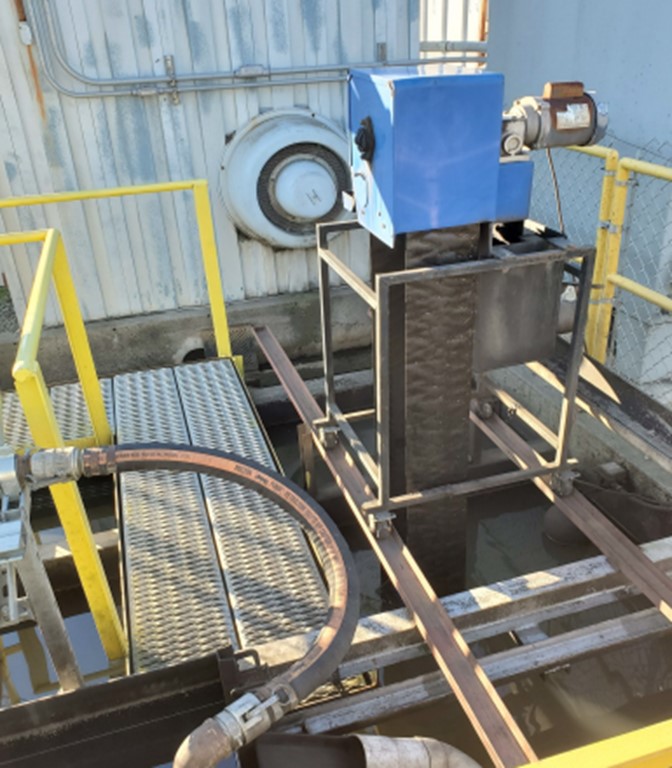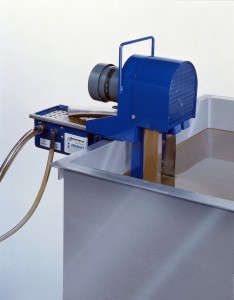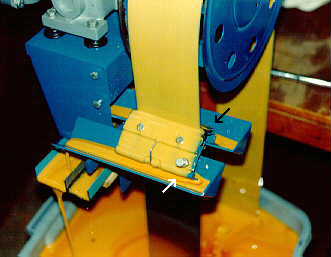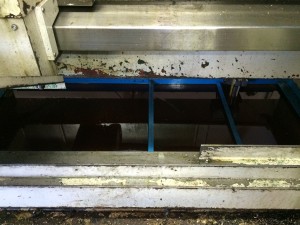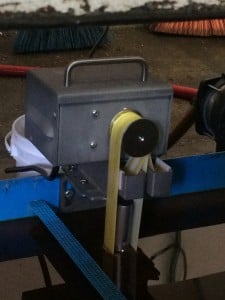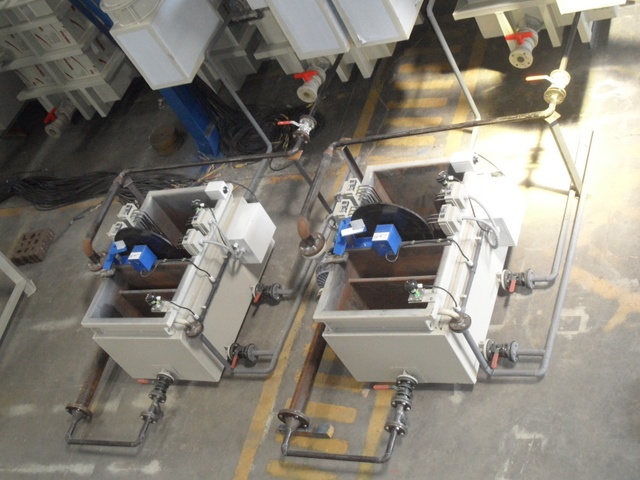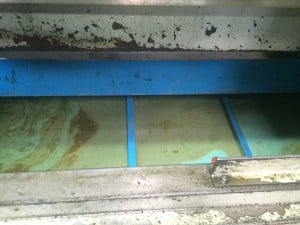There are several things to consider when choosing a belt or tube material for your oil skimmer. Some plastics will not stand up to heat or strong chemicals. Certain metal belts will not skim coolants effectively. Smooth belts do no pick up floating emulsified oils. Specific plastic belts do not last in heated applications, while other types of plastic belts will.
Topics: oil skimmers, belt skimmer, oil concentrator, tote-it, belt oil skimmer
Belt Oil Skimmer Keeps Parts Washers Clean | Abanaki
Have you ever had your clean parts rejected from your customer? Parts that have been cleaned in your parts washers, yet they still have residual oils on them? This happened to one of my customers recently, and it’s not uncommon. Fortunately, there is a simple solution that will save you time, money, and embarrassment of having parts rejected.
Tote-It Belt Oil Skimmer
Abanaki Tote-It Belt Oil Skimmer will remove the oil that is floating on the surface of the parts washer and is being reintroduced onto the clean parts when they are removed from the parts washer. The Tote-It belt oil skimmer removes up to 12 gallons per hour of oil from water, and it is made to withstand the high temperatures and pH levels that can be associated with parts washers.
With its patented design, the Tote-It belt oil skimmer is a dependable and effective means of removing oil from water. The single assembly unit can be used in any application where 115 VAC, 60 Hz power is available.
Belt Oil Skimmer Specifications
The Tote-It belt oil skimmer utilizes a continuous belt and wiper to remove up to 12 gallons of oil per hour from the fluid surface. The belt operates on a motor and pulley system attached to a stabilizer bar that is immersed in the contaminated liquid. After traveling over the head pulley, the belt passes through tandem wiper blades where oil is scraped off both sides of the belt, and discharged through a 1-1/4 in. ID hose. The tail pulley has flanges which allow it to roll freely on the inside of the belt without becoming dislodged. It does not need to be fastened to the tank.
Advantages of Belt Oil Skimmer
The Tote-It belt oil skimmer is especially well suited for parts washing and machining center applications. By removing surface oil from a wash tank, the parts will not be re-contaminated as they are withdrawn. Removing tramp oil from a coolant tank prevents excessive smoke and fumes due to oil burning during cutting operations. It also reduces bacteria growth in the tank, along with the resulting odor.
Video: How Does a Portable Oil Skimmer Work?
To learn more about oil skimmers, please contact our experts at 440-543-7400 or visit our website: www.abanaki.com
You are just one step away from downloading the most dependable and effective Tote-It Belt Oil Skimmer brochure. Simply click at the button to get your brochure now.
Topics: oil skimmers, belt skimmer, oil skimming, tote-it, belt oil skimmer, different oil skimmer industrial, industrial oil Skimmers, oil skimmers applications
6 Types of Oil Skimmers | Belt, Rope, Mop & More | Abanaki
For industrial oil skimming, there are six basic designs commonly used:
- Belt Skimmers
- Disk Skimmers
- Drum/Barrel Styles
- Mop Skimmers
- Tube Skimmers (Large and Mini)
- Floating Suction Skimmers
Check out our Oil Skimming Guide to learn more.
Belt Oil Skimmers
Belt-type oil skimmers use an endless belt of corrosion resistant steel or synthetic medium, which is lowered into the tank or vessel to be skimmed. The belt passes through resilient wiper blades where the oil is removed from both sides of the medium.
Belt machines provide a simple, dependable and cost-effective method for removing oil, grease and other hydrocarbons from water.
Disk Oil Skimmers
These oil skimmers rotate a disk-shaped medium through the liquid. Oil is wiped off and discharged into a collection container in a manner similar to belt oil skimmers. It is important to consider reach, the portion of the disk that actually gets immersed,
when looking at a disk oil skimmer. Less disk in the fluid means less oil removed. Obviously, fluctuating fluids can be a real problem for disk oil skimmers.
Drum/Barrel Styles
These are similar to the disk type, but use a rotating drum shaped medium. Compared to disk types, they are usually more rugged and have higher removal capacity. Depending on the design, these units can also be rendered ineffective by fluctuating fluid levels. Also, water pickup with this type of oil skimmer can be high.
Mop Oil Skimmers
These oil skimmers use an endless medium shaped like a rope and having mop-like tendrils that pick up the oil. As the medium leaves the liquid and enters the drive unit, it is pressed and wrung out with pinch rollers. For higher viscosity oils, the medium tends to mat down and lose effectiveness. A decant system is a must for these units, as water pickup can be very high. Also, replacement oil mops can be very expensive, so check prices on replacements before purchasing.
Tube Skimmers
Large Tube Skimmers
Tube oil skimmers use a floating plastic hose that snakes out over the surface of the liquid and is then drawn back through the drive unit where oil is removed. This design requires a relatively large amount of surface area for proper operation. This oil skimmer can skim from very shallow tanks. As a rule, the removal capacity is lower than belt, drum or mop type oil skimmers.
Mini Tube
Very similar to the large tube units, but use either a 3/16″ or a 5/16″ tube instead of 1″. The pickup rate varies from 1 quart/hour to 1.5 gph depending on the diameter of the tube. These tube skimmers are fairly compact, and can fit in tight spots. The better units will have the motor mounted underneath, to bring room required over the lip of the tank down to near zero. The 5/16″ diameter tube is preferable as it has a 1 gph removal capacity and enough stiffness to not drag on the housing and prematurely wipe off oil when being drawn into the unit.
Floating Suction Skimmers
These come in several forms, but all have a floating intake. They are most suitable for relatively thick layers of oil (1/4 inch or higher); otherwise, they tend to ingest large amounts of water. Some machines will actually emulsify oil due to churning as it passes through the suction pump. This type of oil skimmer requires a coalescing or at least a decanting unit to be at all effective. The standard drive on all units is an electric motor and gear reducer. Other drive types available.
To learn more about oil skimmers, please contact our experts at 440-543-7400 or visit our website: www.abanaki.com
Click below and download Abanaki's most detailed resource on our oil skimming equipment.
Topics: oil skimmers, belt skimmer, tote-it, tube skimmer, belt oil skimmer, disk skimmer, mop skimmer, floating suction skimmer, drum skimmer
How to Triple Machine Coolant Life With Oil Skimmers | Abanaki
Topics: oil skimmers, belt skimmer, oil concentrator, tote-it, belt oil skimmer
Oil Skimming Deathmatch: Belt Skimmer vs. Tube Skimmer
It’s the age old question; which is better? The belt skimmer or the tube skimmer for collecting floating surface oils from various applications? Some feel that belt skimmers work better because it takes up less space while still collecting oil from large surface areas. Other people feel that the tube skimmer works better because the tube covers more of the tank or pit’s surface. The fact is that both skimmers use the same principle of breaking the surface tension of the water to allow the oil to adhere to either the belt or the tube.
There are a lot of belt and tube oil skimmers out there, but how do you figure out which one will work best for your specific application? There are two things that should be looked at immediately. First, how many gallons per hour of oil are you looking to remove? Every skimmer model is rated for the gallons per hour that can be removed. The next thing to look at would be the dimensions of your tank. The different sizes of skimmers will be able to pull in oil from different distances. Even if you have a fairly low amount of oil, a smaller skimmer may not work if the surface area is too large.
You can make your own decision which is best by visiting www.abanaki.com . There is a full line of belt skimmers and tube skimmers to compare. Or, the best way to match up a proper skimmer to your exact application is to call your Abanaki sales representative @440-543-7400.
There is a skimming system for virtually any application.Fill out the form, and you will have immediate access to this guide.
Topics: oil skimmers, belt skimmer, oil viper, tote-it, tube skimmer
Oil Skimmers Enable Mines to Reuse Wash Water in Wash Bays
Abanaki oil skimmers have been at work in mines around the world for decades. Typically located in remote areas, wastewater treatment facilities are often not available, so water must be reused onsite. Oil skimming cost-effectively removes oil from wash bays so that the water can either evaporate or can be reused.
When washing large equipment, diesel, oil, and grease, along with mud and debris get rinsed into a sump. Abanaki has three solutions that can be used in this situation: the Oil Grabber Model 4, Portable Tote-It, and the Oil Viper tube skimmer.
The Oil Grabber Model 4 is the most commonly used solution at mines. Its heavy-duty construction withstands the harsh environment inherent to the industry. Specially designed belts can collect all of the oil products present in the wash bay, and coupled with the optional Oil Concentrator, they effectively remove the oil without picking up much water.
The Portable Tote-It works well in smaller wash bays or in other parts of the mine where water and oil are present. As with the rest of Abanaki’s product line, it is available in stainless steel, which resists the strong chemicals that can be present at a mine. Two sizes are available based on belt width: 2″ and 4″.
Abanaki’s Oil Viper tube skimmer has a small footprint, but large recovery rate. The tube “snakes” around the pit and can collect oils and greases with ease. It works very well in shallow sumps or confined spaces.
Oil skimming can reduce the amount of labor needed to keep wash bays clean by mechanically removing the oil. Unlike socks or hand-held skimmers, Abanaki’s equipment is able to run continuously or on a timer to eliminate the need for manual labor. Wash bays are typically small and located near the mining pit and would not merit a large, expensive water filtration system. Oil skimmers are an economical way to remove the oil.
To find out which of our skimmers would suit your application the best, please contact our experts at 440-543-7400, or click the button below to get our Webinar: How to Successfully Implement Oil Skimmers
Topics: oil skimmers, oil viper, model 4, tote-it, industrial Wastewater treatment, mines
Advantages of Using an Oil Skimmer in the Machining Industry
Companies look for effective ways to remove oil from water or coolant to reduce costs and the liability of proper disposal. Another reason for removing the oil is a better work environment. Letting oil remain in the coolant tank allows anaerobic bacteria to grow. Anaerobic bacteria break down the components of coolant, causing it to need changing more frequently. Oil-laden coolant with a high anaerobic bacteria content has two other drawbacks as well. The first drawback is an unpleasant odor caused by the bacteria. The second drawback the smoke generated from the oil-laden coolant coming in contact with the operating cutting tool. One of the easiest ways to remove hydrocarbons from water or coolant is by using an oil skimmer. It is a low maintenance, easy to use tool for removing oil from water or coolant.
The use of an oil skimmer holds many benefits including:
Reduction of Disposal Costs: The cost of disposing oil laden coolant is more expensive than the disposing of oil.
Recycling Opportunities: In some instances, companies may be able to re-use the skimmed oil elsewhere or sell it for recycling, choosing to keep their part of the world cleaner.
Extend Coolant Life: Having oil free coolant can also extend its usefulness and effectiveness, reducing the expense on maintenance and coolant replacement.
Esthetic Benefits: Removing the oil from a machine coolant tank will cut down on the amount of smoke generated from the cutting tool coming into contact with oil laden coolant thereby creating a visibly cleaner workplace.
Extend Tool Life: Removing floating surface oils while aerating and refreshing coolant will extend tool life as well.
Avoid EPA Violations: Many machining and metal working shops turn to aqueous parts cleaning because of limits imposed by the EPA on the discharge of emissions and wastes.
Hygienic Benefits: Keeping coolant oxygenated and oil-free reduces the “rotten egg” odor and bacterial levels are lowered resulting in a cleaner work environment.
Abanaki Corporation manufactures a wide variety of oil skimmers to meet any size application. From a small coolant tank in a CNC lathe to a scale pit in a steel mill, Abanaki Corporation can supply a skimmer to do the job. We manufacture skimmers that can remove from 1 gallon per hour to 200 gallons per hour. We offer turnkey systems with a variety of motors, heat options, stands, and oil concentrators. Our skimmers are used on parts washers, in car washes, wells, steel mills, and any other industry where hydrocarbons need to be removed.
To find out which of our skimmers would suit your application the best, please contact our experts at 440-543-7400, or click the button below to get our Oil Skimming Factbook.
Topics: coolant, tube oil skimmer, oil skimmer, tubetastic, tote-it, coolant skimmer, mighty mini, belt oil skimmer, dirty coolant, disk skimmer, oil boss, oil boss oil skimmer, mighty disk
It is a common question asked every day by people in all fields of industry. Machine shops, steel mills, industrial manufacturers, and many others are faced with the problem of removing oils from coolants and wastewater on an everyday basis. They are faced with high disposal and maintenance costs. Some manufacturers are charged extreme amounts to have their contaminated water treated properly by their local water treatment facility.
Companies look for effective ways to remove oil from water or coolant to reduce costs and the liability of proper disposal. Another reason for removing the oil is a better work environment. Letting oil remain in the coolant tank allows anaerobic bacteria to grow. Anaerobic bacteria break down the components of coolant, causing it to need changing more frequently. Oil-laden coolant with a high anaerobic bacteria content has two other drawbacks as well. The first drawback is an unpleasant odor caused by the bacteria. The second drawback the smoke generated from the oil-laden coolant coming in contact with the operating cutting tool. One of the easiest ways to remove hydrocarbons from water or coolant is by using a belt oil skimmer. It is a low maintenance, easy to use tool for removing oil from water or coolant.
Belt oil skimmers work because of the differences in specific gravity between oil and water. Water has a specific gravity of one. Most oils have a specific gravity of less than one. Because of these differences, oil floats to the top of the water where it can be removed. A belt oil skimmer uses oil oleophilic material, (usually made of stainless steel or plastic), in the form of a belt to break the surface tension of the water to attract
and collect the floating oil. The belt passes through a set of wiper blades via a motorized head pulley where the oil is wiped off both sides of the belt. The oil then flows through the skimmer troughs and into a proper disposal container. Because the belt materials used do not attract water, very little coolant or water is picked up.
Some of the advantages of using a belt oil skimmer over other methods to remove oil are the lower initial cost compared to coalescers and other filtration systems, low maintenance, no filters to change, and no mess involved as with absorbent booms or pads. With an oil skimmer, virtually the only required maintenance is replacing a belt and wiper blade set as needed. Next, Abanaki skimmers require very little operating space, usually with no modification to the tank. Finally, our oil skimmers have pick-up rates of up to 200 gph with minimal water or coolant content. Other forms of oil removal cannot perform as well.
There are many instances where companies have turned their disposal costs into income. By using an Abanaki oil skimmer to remove oil from the coolant, one company was able to sell its used oil to be recycled instead of being charged to have the oil-contaminated coolant disposed of. Another money saving benefit was an extended coolant life resulting in lower coolant and maintenance costs. Because of this, the Abanaki oil skimmer paid for itself in a short period of time.
Abanaki Corporation manufactures a wide variety of oil skimmers to meet any size application. From a small coolant tank in a CNC lathe to a scale pit in a steel mill, Abanaki Corporation can supply a skimmer to do the job. We manufacture skimmers that can remove from 1 gallon per hour to 200 gallons per hour. We offer turnkey systems with a variety of motors, heat options, stands, and oil concentrators. Our skimmers are used on parts washers, in car washes, wells, steel mills, and any other industry where hydrocarbons need to be removed.
To find out which of our skimmers would suit your application the best, please contact our experts at 440-543-7400, or click the button below to get our Coolant Guide Book.
Topics: coolant, tube oil skimmer, oil skimmer, tubetastic, tote-it, coolant skimmer, mighty mini, belt oil skimmer, dirty coolant, disk skimmer, oil boss, oil boss oil skimmer, mighty disk
How to Select the Right Coolant Oil Skimmer for the Machine Shop
The use of an oil skimmer in the machine shop setting holds many benefits. Removing the oil from a machine coolant tank will initiate some esthetic benefits such as cutting down on the amount of smoke generated from the cutting tool coming into contact with oil laden coolant.
When a machine is shut down for the weekend, oil has a chance to come to the surface of the coolant tank. Bacteria that are living in the coolant tank use up the dissolved oxygen in the coolant mix, a process that is sped up by having a layer of oil on the surface. This allows odor causing anaerobic bacteria to thrive, giving off that familiar “rotten egg” smell.
Contrary to popular belief the common types of bacteria found in metalworking fluids do not cause dermatitis. However, if the skin is broken, bacteria that normally inhabit the skin may enter and cause infection. The presence of phosphates and carbonates that increase alkalinity in the coolant, however, can cause dermatitis. These impurities are found in the water being used in the coolant mix.
Separating the oil from the coolant will also help reduce disposal costs. The cost of disposing of oil laden coolant is more expensive than disposing of oil. In fact, in some instances, companies may be able to re-use the oil elsewhere or sell it for recycling. Having oil free coolant can also extend its usefulness and effectiveness, reducing the expense on maintenance and coolant replacement. As the research on the different types of oil skimmers begins, a person will find that there are a variety of skimmers available to them. The most common types are the belt, disk, and tube skimmers. Each type of coolant skimmer has its advantages and disadvantages.
There are also many factors that need to be considered when choosing the correct type of oil skimmer to fit the appropriate application. Factors such as water level fluctuation, water temperature, pH level, the use of rust inhibitors, the amount of oil to be skimmed, quality, and cost, must all be considered when selecting an oil skimmer.
The use of rust inhibitors, high temperatures, and variable pH levels can affect the skimmers ability to pick up oil. Most skimmer manufacturers use a variety of materials for the skimming medium such as plastic, stainless steel, or poly blends to match the solution in which they will be used.
There are a multitude of oil skimmers on the market today. One of the most important things to be considered is the quality of the unit to be purchased. Points of interest should include construction materials, motor design, and the type of warranty that is offered. Is the skimmer housing made of metal or plastic? Is the motor fan-cooled? Does the motor use needle bearings or bronze bearings? How long does the warranty last and what does it cover? Most oil skimmers will perform as advertised, but remember the old adage that “you get what you pay for”.
To find out which of our skimmers would suit your application the best, please contact our experts at 440-543-7400, or click the button below to get our Coolant Guide Book.
Topics: coolant, tube oil skimmer, oil skimmer, tubetastic, tote-it, mighty mini, belt oil skimmer, disk skimmer, oil boss oil skimmer, mighty disk
Bill Clinton-era Skimmers Still in Use 20 Years Later
Lasco Fittings, Inc., a global leader in pipe fittings for Irrigation/Golf, Plumbing, Pool/Spa, and Industrial customers, maintains a 26-acre manufacturing facility in Brownsville, Tennessee. Hundreds of different parts with multiple manufacturing processes are created at their extensive facility.
Oil plays a vital, yet bothersome and dirty role in their production. This is where Abanaki Corporation entered the picture for them, as it has for thousands of manufacturers worldwide.
According to Ryan Hilliard, Maintenance Supervisor for Lasco Fittings, 10 Abanaki 2-inch Tote-It oil skimmers were purchased in 1999. “Our (manufacturing) machines leak oil into this 110-foot long, 6-foot deep pit. Our skimmers are permanently mounted on the end of this pit and run 24/7 with very little trouble.”
Lasco periodically inspects and maintains the units, ensuring that the Abanaki skimmers keep the company running with cost-saving, manufacturing-enhancing, and environmentally-compliant benefits.
Abanaki oil skimmers extend the life of parts washers while also making them more efficient — by ending recontamination of parts. Abanaki skimmers have actively served for nearly two decades for a high-quality manufacturer like Lasco Fittings, Inc., and they certainly can for you. Are your parts washers working efficiently?
For further inquiry on Tote-It oil skimmer click below. As always, the Abanaki sales team is here, ready and waiting to help you choose the right oil skimmer for your application.
Topics: coolant, oil skimmer, tote-it, Concentrators


